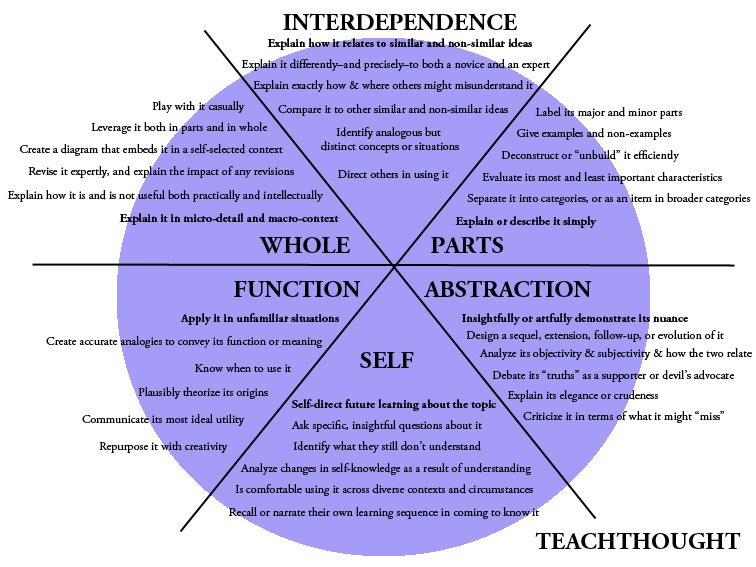
Heick学习分类学
经过特里·希克(Terry Heick)
您如何判断学生是否真正了解某事?
他们很早就学习玩游戏 - 告诉老师和/或测试他们“想知道的”,甚至最好的评估都在桌子上留下了一些东西。(实际上,很大一部分学生根本不知道他们不知道什么。)
The idea of understanding is, of course, at the heart of all learning, and solving it as a puzzle is one of the three pillars of formal learning environments and education.
1.他们需要了解什么(标准)?
2.他们目前了解什么(评估)?
3.他们如何最好地了解他们目前不做的事情(计划学习经验和指导)?
但是我们怎么知道他们是否知道呢?还有,这是什么'?
理解为'它'
从表面上看,“ it”一词听起来很含糊。麻烦。不确定。但是每个人都以某种方式知道这是什么。
“这本质上是要学到的东西,这对老师和学生来说都是可怕的事情。“它”就是一切,以客观,目标,熟练程度,测试,考试,成绩,失败和成功等恐吓术语描述。
And in terms of content, ‘it’ could be almost anything: a fact, a discovery, a habit, skill, or general concept, from mathematical theory to a scientific process, the importance of a historical figure to an author’s purpose in a text.
So if a student gets it, beyond pure academic performance what might they be able to do? There are many existing taxonomies and characteristics, from Bloom’s to Understanding by Design’s6个理解方面。
The following actions are set up as a linear taxonomy, from most basic to the most complex. The best part about it is its simplicity: Most of these actions can be performed simply in the classroom in minutes, and don’t require complex planning or an extended exam period.
通过使用快速图,概念图,T-chart,对话,图片或简短的响应,快速面对面的协作,出口单或通过数字/社交媒体,可以在几分钟内评估理解,通过评估的气氛有助于取代测试和惊讶。它甚至可以在课堂网站上显示或挂在课堂上,以帮助指导自我指导的学习,并检查自己的理解。
这种理解分类学如何有效
我很快就会写更多有关此内容的信息,并尽快将其放入更加图形的形式中;这两者对于使用它都是至关重要的。(更新:我还为教师创建了一门课程,以帮助您,使用它。)目前,我要说的是它可以用来指导计划,评估,课程设计和自我指导的学习。或发展任何内容领域的批判性思维问题。
“ Heick”学习分类法的本质是简单,布置为(主要是)孤立的任务,其复杂性范围从较少到更多。也就是说,学生不必证明“最高”的理解水平,这错过了这一点。完成这些任务的任何能力都是理解的证明。学生可以完成的任务越多,但是所有“检查”的“盒子”都证明了学生“得到它”。
36 Thinking Strategies To Help Students Wrestle With Complexity
Heick学习分类学
域1:零件
- 简单地解释或描述
- 标记其主要和次要零件
- 评估其最重要的特征
- 有效地解构或“解构”
- 举例和非例子
- Separate it into categories, or as an item in broader categories
示例主题
革命战争
示例提示
Explain the Revolutionary War in simple terms (e.g., an inevitable rebellion that created a new nation).
确定革命战争的主要和次要“部分”(例如,经济学和宣传,士兵和关税)。
评估革命战争,并确定其最少,最重要的特征(例如,造成和影响城市名称和小规模冲突)
域2:整体
- Explain it in micro-detail and macro-context
- Create a diagram that embeds it in a self-selected context
- Explain how it is and is not useful both practically and intellectually
- 随便玩
- 在各个部分和整体上利用它
- 熟练地修改它,并解释任何的影响revisions
域3:相互依存
- Explain how it relates to similar and non-similar ideas
- 指导他人使用它
- Explain it differently–and precisely–to both a novice and an expert
- Explain exactly how and where others might misunderstand it
- Compare it to other similar and non-similar ideas
- 确定类似但截然不同的思想,概念或情况
域4:功能
- Apply it in unfamiliar situations
- 创建准确的类比来传达其功能或含义
- 分析其实用程序的最佳位置
- 重新利用创造力
- 知道什么时候使用它
- 合理化其起源
域5:抽象
- 洞察力或巧妙地展示其细微差别
- 批评它可能“错过”或“不诚实”或不完整的地方
- 辩论其“真相”作为支持者或魔鬼的倡导者
- 解释其优雅或粗暴
- Analyze its objectivity and subjectivity, and how the two relate
- Design a sequel, extension, follow-up, or evolution of it
域6:自我
- 关于该主题的自我指导的未来学习
- 询问有关它的具体,有见地的问题
- 回忆或叙述自己的学习顺序或年表(元认知)
- Is comfortable using it across diverse contexts and circumstances
- 确定他们仍然不了解的东西
- 分析理解的自我知识变化
高级理解


